Tho Quan
Speaking in Words, Thinking in Logic: A Dual-Process Framework in QA Systems
Jul 28, 2025Abstract:Recent advances in large language models (LLMs) have significantly enhanced question-answering (QA) capabilities, particularly in open-domain contexts. However, in closed-domain scenarios such as education, healthcare, and law, users demand not only accurate answers but also transparent reasoning and explainable decision-making processes. While neural-symbolic (NeSy) frameworks have emerged as a promising solution, leveraging LLMs for natural language understanding and symbolic systems for formal reasoning, existing approaches often rely on large-scale models and exhibit inefficiencies in translating natural language into formal logic representations. To address these limitations, we introduce Text-JEPA (Text-based Joint-Embedding Predictive Architecture), a lightweight yet effective framework for converting natural language into first-order logic (NL2FOL). Drawing inspiration from dual-system cognitive theory, Text-JEPA emulates System 1 by efficiently generating logic representations, while the Z3 solver operates as System 2, enabling robust logical inference. To rigorously evaluate the NL2FOL-to-reasoning pipeline, we propose a comprehensive evaluation framework comprising three custom metrics: conversion score, reasoning score, and Spearman rho score, which collectively capture the quality of logical translation and its downstream impact on reasoning accuracy. Empirical results on domain-specific datasets demonstrate that Text-JEPA achieves competitive performance with significantly lower computational overhead compared to larger LLM-based systems. Our findings highlight the potential of structured, interpretable reasoning frameworks for building efficient and explainable QA systems in specialized domains.
URAG: Implementing a Unified Hybrid RAG for Precise Answers in University Admission Chatbots -- A Case Study at HCMUT
Jan 27, 2025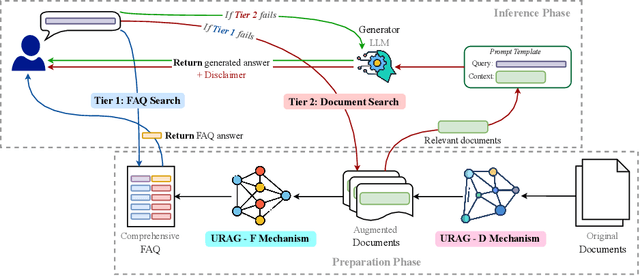
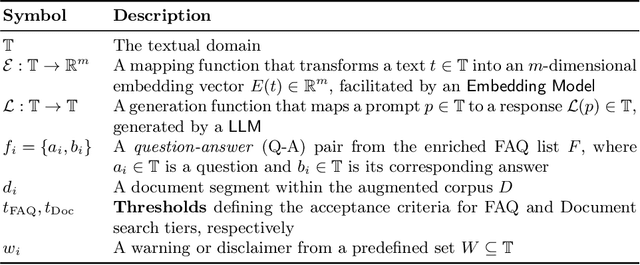

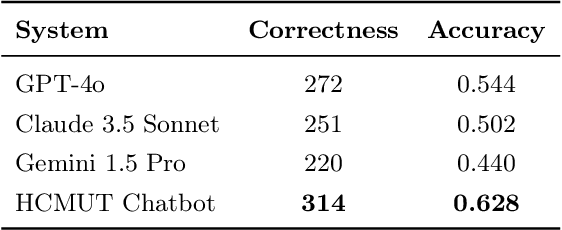
Abstract:With the rapid advancement of Artificial Intelligence, particularly in Natural Language Processing, Large Language Models (LLMs) have become pivotal in educational question-answering systems, especially university admission chatbots. Concepts such as Retrieval-Augmented Generation (RAG) and other advanced techniques have been developed to enhance these systems by integrating specific university data, enabling LLMs to provide informed responses on admissions and academic counseling. However, these enhanced RAG techniques often involve high operational costs and require the training of complex, specialized modules, which poses challenges for practical deployment. Additionally, in the educational context, it is crucial to provide accurate answers to prevent misinformation, a task that LLM-based systems find challenging without appropriate strategies and methods. In this paper, we introduce the Unified RAG (URAG) Framework, a hybrid approach that significantly improves the accuracy of responses, particularly for critical queries. Experimental results demonstrate that URAG enhances our in-house, lightweight model to perform comparably to state-of-the-art commercial models. Moreover, to validate its practical applicability, we conducted a case study at our educational institution, which received positive feedback and acclaim. This study not only proves the effectiveness of URAG but also highlights its feasibility for real-world implementation in educational settings.
RAPID: Retrieval-Augmented Parallel Inference Drafting for Text-Based Video Event Retrieval
Jan 27, 2025



Abstract:Retrieving events from videos using text queries has become increasingly challenging due to the rapid growth of multimedia content. Existing methods for text-based video event retrieval often focus heavily on object-level descriptions, overlooking the crucial role of contextual information. This limitation is especially apparent when queries lack sufficient context, such as missing location details or ambiguous background elements. To address these challenges, we propose a novel system called RAPID (Retrieval-Augmented Parallel Inference Drafting), which leverages advancements in Large Language Models (LLMs) and prompt-based learning to semantically correct and enrich user queries with relevant contextual information. These enriched queries are then processed through parallel retrieval, followed by an evaluation step to select the most relevant results based on their alignment with the original query. Through extensive experiments on our custom-developed dataset, we demonstrate that RAPID significantly outperforms traditional retrieval methods, particularly for contextually incomplete queries. Our system was validated for both speed and accuracy through participation in the Ho Chi Minh City AI Challenge 2024, where it successfully retrieved events from over 300 hours of video. Further evaluation comparing RAPID with the baseline proposed by the competition organizers demonstrated its superior effectiveness, highlighting the strength and robustness of our approach.
Cross-Data Knowledge Graph Construction for LLM-enabled Educational Question-Answering System: A~Case~Study~at~HCMUT
Apr 14, 2024



Abstract:In today's rapidly evolving landscape of Artificial Intelligence, large language models (LLMs) have emerged as a vibrant research topic. LLMs find applications in various fields and contribute significantly. Despite their powerful language capabilities, similar to pre-trained language models (PLMs), LLMs still face challenges in remembering events, incorporating new information, and addressing domain-specific issues or hallucinations. To overcome these limitations, researchers have proposed Retrieval-Augmented Generation (RAG) techniques, some others have proposed the integration of LLMs with Knowledge Graphs (KGs) to provide factual context, thereby improving performance and delivering more accurate feedback to user queries. Education plays a crucial role in human development and progress. With the technology transformation, traditional education is being replaced by digital or blended education. Therefore, educational data in the digital environment is increasing day by day. Data in higher education institutions are diverse, comprising various sources such as unstructured/structured text, relational databases, web/app-based API access, etc. Constructing a Knowledge Graph from these cross-data sources is not a simple task. This article proposes a method for automatically constructing a Knowledge Graph from multiple data sources and discusses some initial applications (experimental trials) of KG in conjunction with LLMs for question-answering tasks.
Crossing Linguistic Horizons: Finetuning and Comprehensive Evaluation of Vietnamese Large Language Models
Mar 05, 2024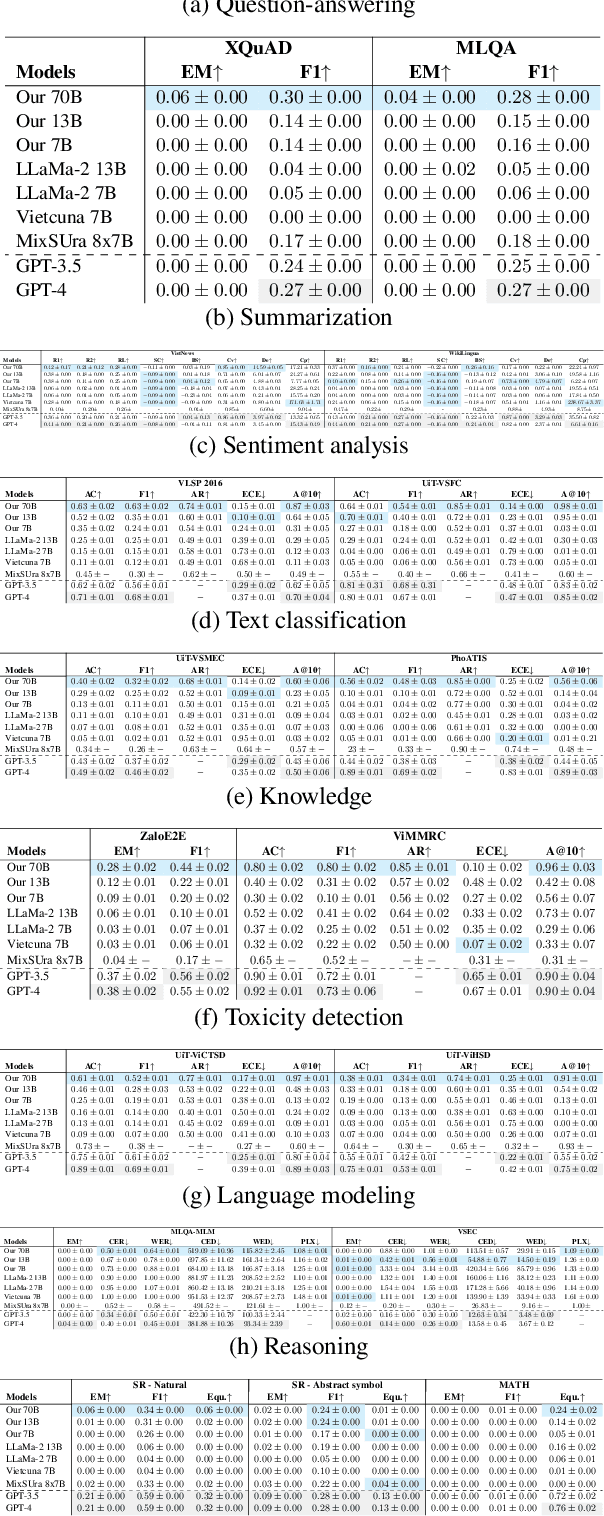
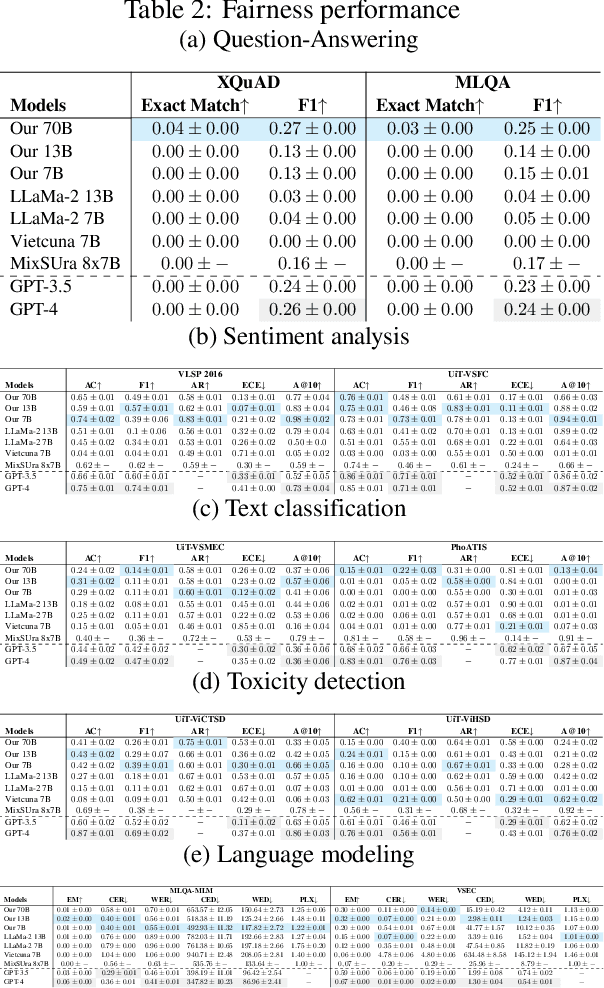
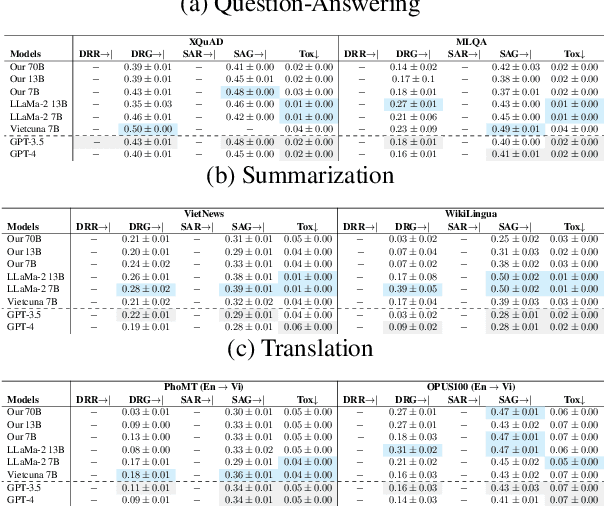

Abstract:Recent advancements in large language models (LLMs) have underscored their importance in the evolution of artificial intelligence. However, despite extensive pretraining on multilingual datasets, available open-sourced LLMs exhibit limited effectiveness in processing Vietnamese. The challenge is exacerbated by the absence of systematic benchmark datasets and metrics tailored for Vietnamese LLM evaluation. To mitigate these issues, we have finetuned LLMs specifically for Vietnamese and developed a comprehensive evaluation framework encompassing 10 common tasks and 31 metrics. Our evaluation results reveal that the fine-tuned LLMs exhibit enhanced comprehension and generative capabilities in Vietnamese. Moreover, our analysis indicates that models with more parameters can introduce more biases and uncalibrated outputs and the key factor influencing LLM performance is the quality of the training or fine-tuning datasets. These insights underscore the significance of meticulous fine-tuning with high-quality datasets in enhancing LLM performance.
LAMPAT: Low-Rank Adaption for Multilingual Paraphrasing Using Adversarial Training
Jan 09, 2024Abstract:Paraphrases are texts that convey the same meaning while using different words or sentence structures. It can be used as an automatic data augmentation tool for many Natural Language Processing tasks, especially when dealing with low-resource languages, where data shortage is a significant problem. To generate a paraphrase in multilingual settings, previous studies have leveraged the knowledge from the machine translation field, i.e., forming a paraphrase through zero-shot machine translation in the same language. Despite good performance on human evaluation, those methods still require parallel translation datasets, thus making them inapplicable to languages that do not have parallel corpora. To mitigate that problem, we proposed the first unsupervised multilingual paraphrasing model, LAMPAT ($\textbf{L}$ow-rank $\textbf{A}$daptation for $\textbf{M}$ultilingual $\textbf{P}$araphrasing using $\textbf{A}$dversarial $\textbf{T}$raining), by which monolingual dataset is sufficient enough to generate a human-like and diverse sentence. Throughout the experiments, we found out that our method not only works well for English but can generalize on unseen languages as well. Data and code are available at https://github.com/phkhanhtrinh23/LAMPAT.
Expand BERT Representation with Visual Information via Grounded Language Learning with Multimodal Partial Alignment
Dec 04, 2023



Abstract:Language models have been supervised with both language-only objective and visual grounding in existing studies of visual-grounded language learning. However, due to differences in the distribution and scale of visual-grounded datasets and language corpora, the language model tends to mix up the context of the tokens that occurred in the grounded data with those that do not. As a result, during representation learning, there is a mismatch between the visual information and the contextual meaning of the sentence. To overcome this limitation, we propose GroundedBERT - a grounded language learning method that enhances the BERT representation with visually grounded information. GroundedBERT comprises two components: (i) the original BERT which captures the contextual representation of words learned from the language corpora, and (ii) a visual grounding module which captures visual information learned from visual-grounded datasets. Moreover, we employ Optimal Transport (OT), specifically its partial variant, to solve the fractional alignment problem between the two modalities. Our proposed method significantly outperforms the baseline language models on various language tasks of the GLUE and SQuAD datasets.
Enriching and Controlling Global Semantics for Text Summarization
Sep 22, 2021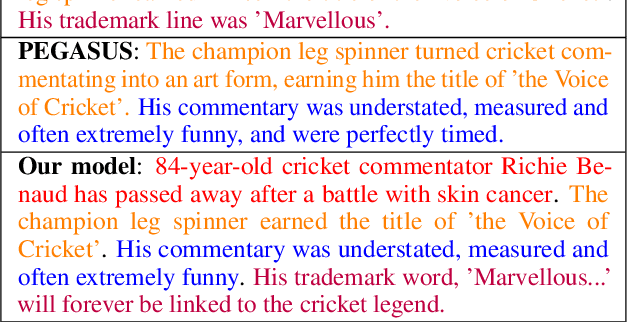

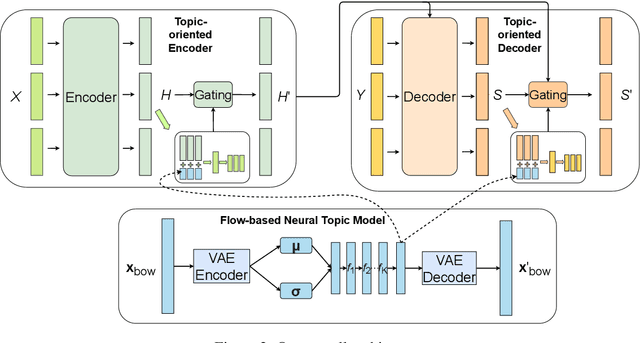

Abstract:Recently, Transformer-based models have been proven effective in the abstractive summarization task by creating fluent and informative summaries. Nevertheless, these models still suffer from the short-range dependency problem, causing them to produce summaries that miss the key points of document. In this paper, we attempt to address this issue by introducing a neural topic model empowered with normalizing flow to capture the global semantics of the document, which are then integrated into the summarization model. In addition, to avoid the overwhelming effect of global semantics on contextualized representation, we introduce a mechanism to control the amount of global semantics supplied to the text generation module. Our method outperforms state-of-the-art summarization models on five common text summarization datasets, namely CNN/DailyMail, XSum, Reddit TIFU, arXiv, and PubMed.
PageRank algorithm for Directed Hypergraph
Aug 29, 2019

Abstract:During the last two decades, we easilly see that the World Wide Web's link structure is modeled as the directed graph. In this paper, we will model the World Wide Web's link structure as the directed hypergraph. Moreover, we will develop the PageRank algorithm for this directed hypergraph. Due to the lack of the World Wide Web directed hypergraph datasets, we will apply the PageRank algorithm to the metabolic network which is the directed hypergraph itself. The experiments show that our novel PageRank algorithm is successfully applied to this metabolic network.
Nested Variational Autoencoder for Topic Modeling on Microtexts with Word Vectors
Jun 03, 2019
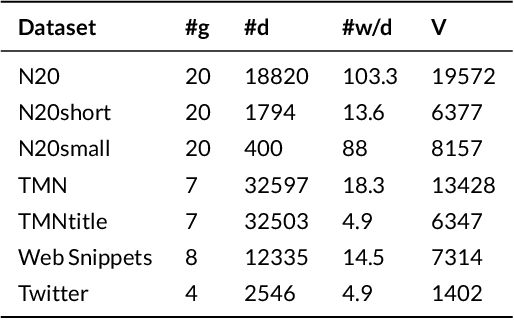
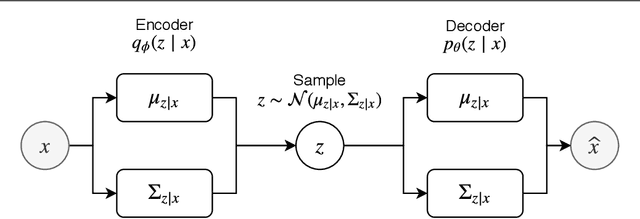
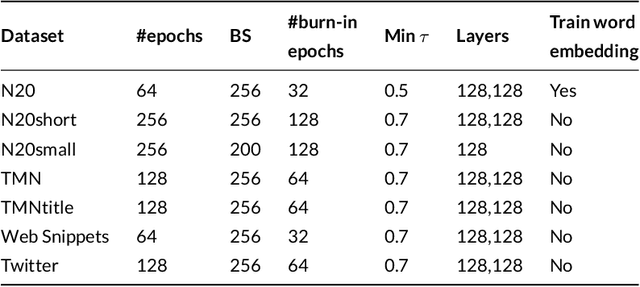
Abstract:Most of the information on the Internet is represented in the form of microtexts, which are short text snippets like news headlines or tweets. These source of information is abundant and mining this data could uncover meaningful insights. Topic modeling is one of the popular methods to extract knowledge from a collection of documents, nevertheless conventional topic models such as Latent Dirichlet Allocation (LDA) is unable to perform well on short documents, mostly due to the scarcity of word co-occurrence statistics embedded in the data. The objective of our research is to create a topic model which can achieve great performances on microtexts while requiring a small runtime for scalability to large datasets. To solve the lack of information of microtexts, we allow our method to take advantage of word embeddings for additional knowledge of relationships between words. For speed and scalability, we apply Auto-Encoding Variational Bayes, an algorithm that can perform efficient black-box inference in probabilistic models. The result of our work is a novel topic model called Nested Variational Autoencoder which is a distribution that takes into account word vectors and is parameterized by a neural network architecture. For optimization, the model is trained to approximate the posterior distribution of the original LDA model. Experiments show the improvements of our model on microtexts as well as its runtime advantage.
 Add to Chrome
Add to Chrome Add to Firefox
Add to Firefox Add to Edge
Add to Edge